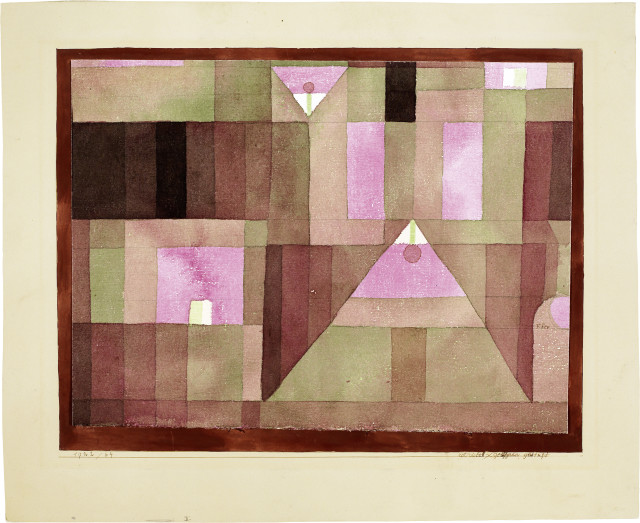- FR
S’inscrire
- Acheter
- Vendre
- Plus
- Galerie
- Commerce d'art
- Maison d'Édition
- Kornfeld aujourd’hui
- L'histoire de la Maison
- Informations



Münchenbuchsee bei Bern 1879 - 1940 Muralto
1922 - work number 1922.64
Watercolour over preliminary drawing in pencil on Whatman watercolour paper, mounted on cardboard, on the cardboard with a border in watercolour surrounded
21,2x29,2/28,5 cm, watercolour - 23,6x30,4 cm, border and closing line - 30x37 cm, cardboard
Inside the image on the right signed by the artist in pen and ink "Klee", the cardboard mount with the border line, above it the work number "1922 / 64" and title on the right "rot/violett x gelb/grün gestuft"
Paul Klee, Catalogue raisonné, volume 3, Werke 1919-1922, no. 2888
Lily Klee, Bern (1940-1946)
Klee-Gesellschaft, Bern (1946-1952)
Felix Klee, Bern (1953-1990)
Estate of Felix Klee (1990-1995)
Private collection, Switzerland
Selection:
Dresden 1924, Galerie Neue Kunst Fides, Paul Klee (no catalogue)
Munich 1925, Galerie Hans Goltz, 100. Ausstellung: Paul Klee 1920-1925, cat. no. 62
Gera 1925-1926, Geraer Kunstverein, Paul Klee, cat. no. 39
St. Gallen 1955, Kunstmuseum, Klee, Werke aus dem Familienbesitz, cat. no. 125
Bern 1956, Kunstmuseum/Paul Klee Stiftung, Paul Klee, cat. no. 472
Hamburg 1956, Kunsthalle, Paul Klee, cat. no. 128
Amsterdam 1963, Stedelijk Museum, Paul Klee, Tentoonstelling aquarellen, cat. no. 20
Essen 1969, Museum Folkwang, Paul Klee, cat. no. 60, ill. p. 68
Buenos Aires/Montevideo 1970, Museo Nacional, Paul Klee, cat. no. 33
Lissabon 1972, Museu Calouste Gulbenkian, Paul Klee, cat. no. 66, colour ill.
Hanover 1980, Kestner Gesellschaft, Paul Klee, Sammlung Felix Klee, cat. no. 66, ill.
Tokyo 1980, The Seibu Museum of Art, Paul Klee, cat. no. 89, colour ill.
Paris 1985/1986, Centre Georges Pompidou, Klee et la musique, cat. no. 117, ill.
Frankfurt a/M, Schirn Kunsthalle, Paul Klee und die Musik, cat. no. 35, ill.
Tokyo/Osaka/Shimonoseki/Okayama/Hakone 1989-1990, Paul Klee, Das Frühwerk, cat. no. 114, colour ill.
Mannheim 1990/1991, Städtische Kunsthalle, Paul Klee, Konstruktion - Intuition, colour ill. p. 146
Riehen 2017/2018, Fondation Beyeler, Paul Klee, Die abstrakte Dimension, colour ill. p. 119
In perfect condition, entirely fresh colours
In October 1920 Klee was appointed master at the Staatliches Bauhaus in Weimar by Walter Gropius and began teaching in January 1921. Other masters were Feininger, Itten, Marcks, Schlemmer and, in 1922, Kandinsky joined with whom Klee had been friendly since his early time in Munich XXX The present work was created in 1922 at the height of Klee's activity at the Bauhaus, strongly influenced by the teaching of architecture and the return to simple cubic forms and the impressive play of delicate colors, it must certainly be considered one of the main works of this period
1922 - Werknummer 1922.64
Aquarell über Bleistiftvorzeichnung auf Whatman Aquarellpapier, auf Karton aufgelegt, auf dem Karton in Aquarell umrandet
21,2x29,2/28,5 cm, Aquarell - 23,6x30,4 cm, Einfassung und Abschlussstrich - 30x37 cm, Unterlagekarton
Rechts in der Darstellung vom Künstler in Feder in Tusche signiert "Klee", auf dem Unterlagekarton mit Abschlussstrich, darüber mit der Werknummer "1922 / 64" und rechts dem vollen Titel "rot/violett x gelb/grün gestuft"
Paul Klee, Catalogue raisonné, Band 3, Werke 1919-1922,
Lily Klee, Bern (1940-1946)
Klee-Gesellschaft, Bern (1946-1952)
Felix Klee, Bern (1953-1990)
Nachlass Felix Klee (1990-1995)
Privatsammlung Schweiz
Auswahl:
Dresden 1924, Galerie Neue Kunst Fides, Paul Klee (ohne Katalog)
München 1925, Galerie Hans Goltz, 100. Ausstellung: Paul Klee 1920-1925,
Gera 1925-1926, Geraer Kunstverein, Paul Klee,
St. Gallen 1955, Kunstmuseum, Klee, Werke aus dem Familienbesitz,
Bern 1956, Kunstmuseum/Paul Klee Stiftung, Paul Klee,
Hamburg 1956, Kunsthalle, Paul Klee,
Amsterdam 1963, Stedelijk Museum, Paul Klee, Tentoonstelling aquarellen,
Essen 1969, Museum Folkwang, Paul Klee,
Buenos Aires/Montevideo 1970, Museo Nacional, Paul Klee,
Lissabon 1972, Museu Calouste Gulbenkian, Paul Klee,
Hannover 1980, Kestner Gesellschaft, Paul Klee, Sammlung Felix Klee,
Tokyo 1980, The Seibu Museum of Art, Paul Klee,
Paris 1985/1986, Centre Georges Pompidou, Klee et la musique,
Frankfurt a/M 1986, Schirn Kunsthalle, Paul Klee und die Musik,
Tokyo/Osaka/Shimonoseki/Okayama/Hakone 1989-1990, Paul Klee, Das Frühwerk,
Mannheim 1990/1991, Städtische Kunsthalle, Paul Klee, Konstruktion - Intuition, reprod. in Farben pag. 146
Riehen 2017/2018, Fondation Beyeler, Paul Klee, Die abstrakte Dimension, reprod. in Farben pag. 119
In perfekter Erhaltung, vollkommen farbfrisch
Klee wurde im Oktober 1920 von Walter Gropius als Meister an das Staatliche Bauhaus in Weimar berufen und begann seine Lehrtätigkeit im Januar 1921. Weitere Meister waren Feininger, Itten, Marcks, Schlemmer und 1922 kam auch noch Kandinsky dazu, mit dem Klee bereits aus der frühen Münchner Zeit bekannt war
Das vorliegende Werk entstand 1922 auf dem Höhepunkt von Klees Tätigkeit am Bauhaus, stark beeinflusst durch die Lehre der Architektur und die Rückbesinnung auf einfache kubische Formen und das eindrückliche Spiel mit zarten Farben, es muss sicher als eines der Hauptwerke dieser Epoche betrachtet werden




